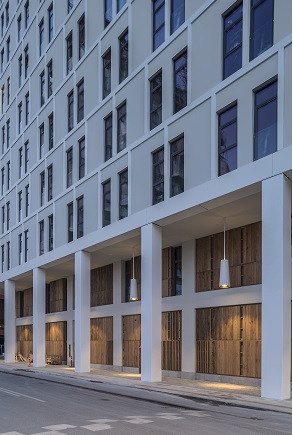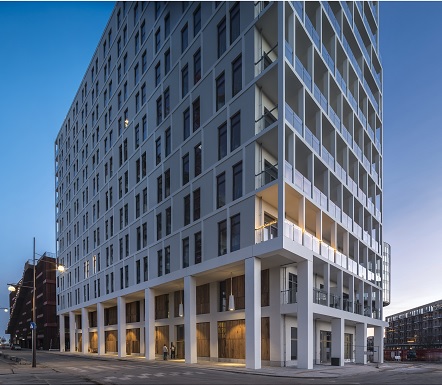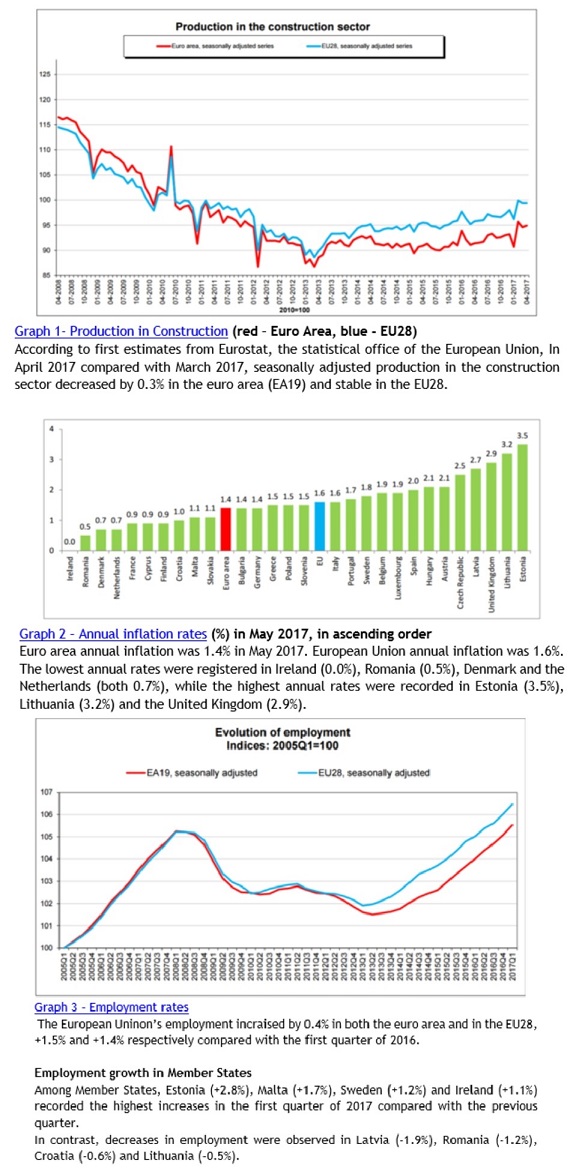Concrete Perspectives June 2017
Construction Sector
Construction Products Europe Annual report is published, please find it here.
Summary of the first EU Industry Day organised last 28 February was published.
CEMBUREAU’s Activity Report is available here.
Conclusions of European Concil on industry
The Head of States decided to insert a specific point on industrial policy in the Conclusions of the European Council (22-23 June 2017). The text says “Building on the Council conclusions of May 2017, which call for a future industrial policy strategy, the European Council underlines the essential role of industry as a major driver for growth, employment and innovation in Europe. In line with its own earlier conclusions, it calls for concrete action to ensure a strong and competitive industrial base of the Single Market” (page 8 point 15).
This achievement is due to the advocay of the Joint Declaration for a Strong Industrial Policy, which has 128 signatories (including BIBM as well).
New report of Cement Sustainability Initiative
On 20 June, the Cement Sustainability Initiative published a report entitled “Development of State of the Art Techniques in Cement Manufacturing: Trying to Look Ahead”.
The paper focuses on the availability of the latest technologies and the need to scale up research and development that can help the cement industry mitigate its greenhouse gas emissions.
The report includes 52 individual papers on well-known existing technologies and seven summary papers telling state-of-the-art and anticipated technological developments related to CO2 emissions in cement production.
The European Cement Research Academy (ECRA) helped CSI with the review of the mentioned papers. Furthermore, a complete stakeholder consultation analysed the production, involving experts from various cement companies, researchers and international organizations. They also ensured that the analysis reflects the most up-to-date knowledge.
These papers are used to update the global cement technology roadmap, which will be presented at COP 23 in Bonn, Germany.
Demoliton, Decontamination and Recycling Expo
The Demoliton, Decontamination and Recycling Expo (DDR Expo) took place 14-16 June with great interest from the industry. On the first day of the conference, the Concrete Initiative organised a workshop entitled “Concrete Initiative Workshop” where sustainable buisness models and opportunities hidden in the concrete value chain was presented and discussed.
On the second day, there was a session on “Recycling concrete: a circular economy model” in which best practices and innovative new practices were presented. Furthermore, best practices in aggregate recycling were presnted as well.
The EU project called “VEEP” was also presented at the expo. The expo offered over 20 different presentations.
By filling the satisfactory survey, it is possible to download the Conference book in the next 15 days (until 7 July).
Best moments of the expo can be checekd here.
European Commission Workshop on “Smart readiness indicator”
On 7 June, a workshop on “Smart readiness indicator for Buildings” was organised in the framework of the recast Energy Performance of Building Directive.
The project is expected to be finished by July 2018. The milestones of the projects are:
- Prepare a catalogue of smart ready services (summer 2017)
- Definition of smart ready indicator(s) (November 2017)
- Stakeholder consultation (throughout the whole project)
- EU impact assessment (April 2018)
If you wish to read the rest of the article, please contact zk@bibm.eu.
Live from the European Union
Energy Council fails to commit to meaningful energy efficiency targets and measures
On 26 June , Energy ministers gathered together to discuss the two key energy efficiency legislation post 2020. Supportive and reluctant Member States difficulty agreed on a common position which could halve the annual energy saving requirement after 2020. Also, they postponed the decision about the binding nature of the 2030 target, failing to express a strong commitment to energy efficiency.
The adopted text weakens the original 2030 target of 30% proposed by the Commission by removing the wording “binding” and deletes the 2050 perspective for the annual energy savings requirement.
Further information on EurActiv
Press Release of the Council of EU (Energy Efficiency Directive)
Press Release of the Council of EU (Energy Performance of Building Directive)
European Parliament adopts Effort Sharing Regulation
On 14 June, the European Parliament adopted the Effort Sharing Regulation. With this adoption, the Parliament sent a strong signal – after the US withdrawal from the Paris agreement- to commit to deliver the EU’s overall target for 2030.
The legislation covers almost two third of the greenhouse gases and aims to reduce emissions not covered by the EU’s emissions trading system by 30% by 2030.
The law will make it possible to break down the EU targets into binding, national ones for sectors not covered by the EU carbon market – i.e. agriculture, transport, building and waste, which together account for about 60% of the EU’s greenhouse gas emissions.
To guarantee long-term predictability, MEPs also set a target for 2050, of reducing greenhouse gas emissions by 80% compared to 2005 levels.
MEPs opened negotiations with Council with an aim to reach a first reading agreement on the proposal. Informal “trilogue” negotiations will start soon.
EU’s Union greenhouse gas emissions increase
According to the data published by new European Environment Agency (EEA) on 1 June 2017, the total European Union greenhouse gas emissions increased by 0.5 % in 2015.
The main emitter was the transport sector, the gains in the fuel efficiency were not enough to counterbalance the additional emissions caused by a higher demand. The EEA’s new reports, ‘Annual European Union greenhouse gas inventory 1990-2015 and inventory report 2017’ and ‘Analysis of key trends and drivers in greenhouse gas emissions in the EU between 1990 and 2015’ provide an overview of the EU’s greenhouse gas emission trends.
For further information please visit the EEA’s press release.
National Award Winner Project
Funen architects Mette Tony and Mads Bjørn Hansen of Praksis Arkitekter in Troense on Tåsinge awarded Betonelement Prize 2017 and Utzon statuette – popularly known as the construction industry’s Oscar. They have been awarded the Concrete Element Price and the statuette for their special architectural concept, for the transformation of Frihavns Tower – a worn out grain silo in Copenhagen’s new fashionable neighborhood, Nordhavn -into a sustainable housing of high architectural quality.
Picture source: http://www.bef.dk/inspiration/betonelement-prisen/vinder-2017/



Pleasure to touch the building
– Frihavns Tower is an original example that old industrial buildings are excellent basic material to work with. Praksis Arkitekter managed to create a beautiful connection between the overall architectural concept and the details that gives the viewer the desire to get closer, want to touch the building, says the chairman of Concrete Element Price jury, Kent Martinussen, CEO of the Danish Architecture Center.
The jury highlighted the silo’s north facade, which has inserted fields with oak planks. The motif of oak on concrete continues in the public access roads and in the apartments as flooring. The north façade is a display of how beautiful solutions are possible with precast concrete. The facade is a huge repetitive surface with delicate rhythms and depth, carried by a walkway of concrete columns.

The architects say that they “… have placed great emphasis on preserving the historical identity and homogenous form of the building and at the same time add a modern ease by surrounding the appartments with large, generous balconies …”
The Concrete Element Prize was established by the Danish Precast Concrete Association in 1978. It is given in recognition of outstanding architectural merits using concrete in a building. The Concrete Element Prize has previously been awarded to many outstanding Danish architects, including Signe and Christian Cold, Lene Tranberg, Bjarke Ingels and Kim, Jan and Jørn Utzon.

About Frihavns Tower
- 78 apartments in Nordhavn (Østerbro, Copenhagen)
- Frihavns tower has a living area of 11.000 kvm, which is spread on 12 floors with 3 – 3,7 meters to the ceiling and large balconies. The individual apartments vary from 62 to 230 m2
- The lobby is patinated with oak-panels, raw concrete and a ceiling of 4.70 meters
- The roof garden is a common space, it overlooks the Copenhagen towers, to the coast and to Malmö
- All apartments have wide terraces in a natural extension of the indoor environment
CONTRACTOR: HHM A/S
YEAR: 2016
ARCHITECT: Praksis Arkitekter
ENGINEER: Henry Jensen Rådgivende Ingeniører A/S
News in brief

News
JULY 2017
04 July
CEN/TC 104/TG 20 Carbonation
Brussels, Belgium
05 July
PEF for Buildings workshop
Brussels, Belgium
05 July
CPE Sustainability WG
Brussels, Belgium
07 July
Concrete Initiative AhG
Brussels, Belgium
11 July
CEN/TC 229/WG 4
Brussels, Belgium
SEPTEMBER 2017
07 September
Resource Efficient Buildings workshop (tbc)
Brussels, Belgium
08 September
ECP TF Fire and Eurocodes
Confcall
14 September
BIBM Technical Commission
Brussels, Belgium
25 September
Concrete Initiative on Energy Efficiency
Brussels, Belgium
The 6th edition of the IPHA Newsletter is available here.
To the Newsletter of Construction Products Europe (former CEPMC), please follow this link.
To read the Newsletter of CEMBUREAU, please follow this link. You can also subscribe directly following this link http://www.cembureau.eu/newsletter/subscriptions.
To read the Quarterly Newsletter of The Concrete Initiative, please follow this link.
List of Acronyms:
CPE – Construction Product Europe
DG GROW – Directorate-General for Internal Market, Industry, Entrepreneurship and SMEs
ECP – European Concrete Platform
EMA – European Masonry Alliance
IPHA – International Pre-stressed Hollowcore Association
TF – Task Force
VEEP Project- Cost-Effective Recycling of CDW in High Added Value Energy Efficient Prefabricated Concrete Components for Massive Retrofitting of our Built Environment
